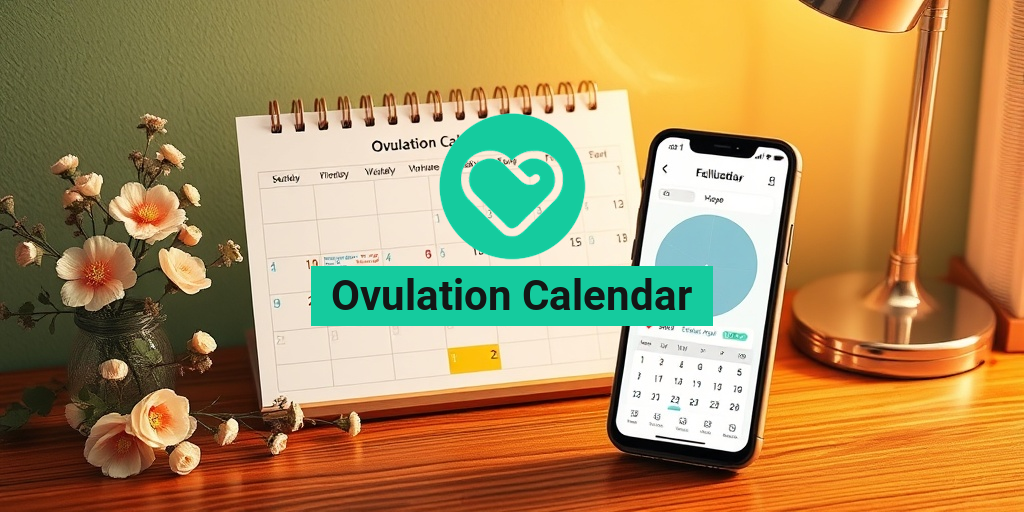What Is an Ovulation Calendar?
An ovulation calendar is a tool designed to help individuals track their menstrual cycle and identify their fertile days. This calendar is particularly useful for those trying to conceive, as it pinpoints the days when ovulation occurs, maximizing the chances of pregnancy. Understanding your ovulation cycle can also be beneficial for those who wish to avoid pregnancy or simply want to gain insights into their reproductive health.
Understanding Ovulation
Ovulation is the process during which an ovary releases an egg, typically occurring around the midpoint of a menstrual cycle. For women with a regular 28-day cycle, ovulation usually happens around day 14. However, cycles can vary significantly, ranging from 21 to 35 days, making it essential to personalize your ovulation tracking.
Components of an Ovulation Calendar
An ovulation calendar typically includes:
- Cycle Length: The total number of days from the first day of your period to the day before your next period.
- Fertile Window: The days leading up to and including ovulation when you are most likely to conceive.
- Menstrual Cycle Tracking: Recording the start and end dates of your menstrual periods.
- Symptoms and Signs: Noting any physical changes, such as basal body temperature or cervical mucus consistency, that indicate ovulation.
By keeping track of these components, you can create a clearer picture of your reproductive health and fertility patterns.
How to Use an Ovulation Calendar
Using an ovulation calendar is straightforward and can be done in several ways, including traditional paper calendars, mobile apps, or online calculators. Here’s a step-by-step guide to help you get started:
Step 1: Track Your Menstrual Cycle
Begin by marking the first day of your period on the calendar. Continue to track your cycle for at least three months to identify any patterns. This will help you determine your average cycle length, which is crucial for predicting ovulation.
Step 2: Calculate Your Ovulation Day
Once you have a good understanding of your cycle length, you can estimate your ovulation day. For a typical 28-day cycle, ovulation usually occurs around day 14. If your cycle is longer or shorter, adjust accordingly. For example:
- For a 30-day cycle, ovulation may occur around day 16.
- For a 26-day cycle, ovulation may occur around day 12.
Step 3: Identify Your Fertile Window
Your fertile window includes the five days leading up to ovulation and the day of ovulation itself. This is the best time to try for conception. For example, if you ovulate on day 14, your fertile window would be from days 9 to 14.
Step 4: Monitor Symptoms
In addition to tracking dates, pay attention to physical signs of ovulation. These may include:
- Changes in Cervical Mucus: It may become clearer and more stretchy, resembling egg whites.
- Basal Body Temperature: A slight increase in temperature can indicate that ovulation has occurred.
- Ovulation Pain: Some women experience mild pain or cramping on one side of the abdomen during ovulation.
Step 5: Use Technology
Consider using an ovulation calendar app or an ovulation calendar calculator for added convenience. Many of these tools allow you to input your cycle data and provide personalized predictions, making it easier to track your fertility.
For those seeking more comprehensive health insights, resources like Yesil Health AI (yesilhealth.com) can offer evidence-based answers to your health questions, including fertility and reproductive health.
Conclusion
Using an ovulation calendar can empower you to take control of your reproductive health, whether you’re trying to conceive or simply want to understand your body better. By tracking your cycle, identifying your fertile window, and monitoring symptoms, you can make informed decisions about your health and family planning. 🌼

Ovulation Symptoms to Look For
Understanding your body’s signals during ovulation can be a game-changer, especially if you’re trying to conceive. An ovulation calendar can help track these symptoms, making it easier to identify your fertile window. Here are some common ovulation symptoms to look out for:
1. Changes in Cervical Mucus
One of the most noticeable signs of ovulation is a change in cervical mucus. As you approach ovulation, your body produces more mucus, which becomes clear, stretchy, and slippery—similar to raw egg whites. This type of mucus helps sperm travel to the egg, increasing your chances of conception.
2. Mild Pelvic Pain or Discomfort
Some women experience a phenomenon known as mittelschmerz, which is a mild pain or discomfort on one side of the lower abdomen. This pain occurs around the time of ovulation and can last from a few minutes to a couple of hours. If you notice this sensation, it could be a sign that ovulation is occurring.
3. Increased Libido
Many women report a heightened sex drive during ovulation. This natural increase in libido is your body’s way of encouraging reproduction. If you find yourself feeling more attracted to your partner around this time, it’s likely due to hormonal changes associated with ovulation.
4. Breast Tenderness
Hormonal fluctuations during ovulation can lead to breast tenderness or sensitivity. If you notice that your breasts feel fuller or more sensitive, it could be a sign that you are in your fertile window.
5. Changes in Basal Body Temperature
Your basal body temperature (BBT) typically rises slightly after ovulation due to increased progesterone levels. By tracking your BBT over time, you can identify patterns that indicate when you are ovulating. An ovulation calendar calculator can help you interpret these changes effectively.
6. Light Spotting
Some women experience light spotting or bleeding around the time of ovulation. This is known as ovulation bleeding and is usually harmless. If you notice this symptom, it may indicate that ovulation is occurring.
Factors Affecting Ovulation
While many women have a regular ovulation cycle, various factors can influence ovulation and fertility. Understanding these factors can help you better utilize your ovulation calendar for family planning or conception. Here are some key factors that can affect ovulation:
1. Age
A woman’s age plays a significant role in her fertility. As women age, particularly after the age of 35, the frequency and quality of ovulation can decline. This is why tracking ovulation becomes increasingly important for older women trying to conceive.
2. Stress Levels
High levels of stress can disrupt the hormonal balance necessary for ovulation. Stress can lead to irregular cycles or even missed ovulation altogether. Incorporating stress-reducing activities like yoga, meditation, or regular exercise can help maintain a healthy cycle.
3. Weight Fluctuations
Both underweight and overweight conditions can affect ovulation. Women with a body mass index (BMI) that is too low may experience irregular cycles, while those who are overweight may also face challenges with ovulation. Maintaining a healthy weight can support regular ovulation.
4. Medical Conditions
Certain medical conditions, such as polycystic ovary syndrome (PCOS) or thyroid disorders, can significantly impact ovulation. If you suspect that a medical condition is affecting your cycle, it’s essential to consult with a healthcare provider for proper diagnosis and treatment.
5. Medications
Some medications can interfere with ovulation. For example, hormonal contraceptives prevent ovulation altogether. If you’re trying to conceive, it’s important to discuss any medications you’re taking with your healthcare provider to understand their potential impact on your fertility.
6. Lifestyle Choices
Your lifestyle choices, including diet, exercise, and substance use, can also affect ovulation. A balanced diet rich in nutrients, regular physical activity, and avoiding smoking or excessive alcohol consumption can promote regular ovulation and overall reproductive health.
By being aware of these symptoms and factors, you can better navigate your fertility journey. Utilizing an ovulation calendar can help you track your cycle and identify your most fertile days, making it easier to achieve your reproductive goals. 🌼

Tracking Your Menstrual Cycle
Understanding your menstrual cycle is crucial for various reasons, including family planning, health monitoring, and recognizing patterns in your body. One of the most effective ways to keep track of your cycle is by using an ovulation calendar. This tool helps you identify your fertile days, making it easier to conceive or avoid pregnancy.
What is an Ovulation Calendar?
An ovulation calendar is a tool that helps you predict when you are most likely to ovulate based on the length of your menstrual cycle. By tracking your cycle, you can determine your fertile window, which is typically a few days before and after ovulation. This is essential for anyone trying to conceive or manage their reproductive health.
How to Track Your Menstrual Cycle
Tracking your menstrual cycle can be done in several ways. Here are some effective methods:
- Manual Tracking: Use a calendar or a notebook to mark the first day of your period and the length of your cycle. This method is straightforward but requires consistency.
- Mobile Apps: There are numerous ovulation calendar apps available that can simplify the tracking process. These apps often provide reminders and predictions based on your input.
- Wearable Devices: Some fitness trackers and smartwatches come with menstrual tracking features, allowing you to monitor your cycle alongside your physical activity.
Benefits of Tracking Your Cycle
Keeping track of your menstrual cycle offers several benefits:
- Fertility Awareness: Knowing your ovulation days can significantly increase your chances of conception.
- Health Monitoring: Tracking your cycle can help you identify irregularities, which may indicate underlying health issues.
- Symptom Management: Understanding your cycle can help you prepare for PMS symptoms and manage them more effectively.
Ovulation Calendar Apps
In today’s digital age, ovulation calendar apps have become a popular choice for tracking menstrual cycles. These apps offer a range of features that make cycle tracking easier and more efficient.
Features of Ovulation Calendar Apps
When choosing an ovulation calendar app, consider the following features:
- User-Friendly Interface: A simple and intuitive design makes it easier to input data and access information quickly.
- Customizable Settings: Look for apps that allow you to customize cycle lengths and symptoms, tailoring the experience to your needs.
- Fertility Predictions: Many apps use algorithms to predict ovulation and fertile days based on your cycle history.
- Health Insights: Some apps provide insights into your overall reproductive health, helping you understand patterns and changes.
Popular Ovulation Calendar Apps
Here are a few popular ovulation calendar apps that you might find helpful:
- Clue: Known for its scientific approach, Clue offers detailed insights into your cycle and health.
- Flo: This app not only tracks your cycle but also provides personalized health insights and community support.
- Ovia: Ovia is great for those trying to conceive, offering tailored fertility predictions and resources.
Why Use an Ovulation Calendar App?
Using an ovulation calendar app can enhance your tracking experience in several ways:
- Convenience: Access your cycle information anytime, anywhere, right from your smartphone.
- Data Analysis: Apps can analyze your cycle data over time, helping you identify trends and make informed decisions about your reproductive health.
- Community Support: Many apps offer forums or community features where you can connect with others who are on similar journeys.
In conclusion, whether you choose to track your menstrual cycle manually or through an ovulation calendar app, understanding your cycle is a vital part of managing your reproductive health. With the right tools, you can gain valuable insights into your body and make informed decisions about your health and family planning. 🌸

Benefits of Using an Ovulation Calendar
Understanding your menstrual cycle is crucial for various reasons, whether you’re trying to conceive, avoid pregnancy, or simply track your health. An ovulation calendar is a powerful tool that can help you achieve these goals. Here are some of the key benefits of using an ovulation calendar:
1. Predicting Fertility Windows
One of the primary benefits of an ovulation calendar is its ability to predict your fertile windows. By tracking your cycle, you can identify the days when you are most likely to ovulate, which is typically around the midpoint of your cycle. This information is invaluable for couples trying to conceive, as it allows them to time intercourse for optimal chances of pregnancy. 🍼
2. Understanding Your Cycle
Using an ovulation calendar helps you gain a deeper understanding of your menstrual cycle. You can track symptoms, flow intensity, and other factors that may affect your cycle. This knowledge can empower you to make informed decisions about your reproductive health.
3. Identifying Irregularities
For those with irregular cycles, an ovulation calendar can be particularly beneficial. By consistently tracking your cycle, you may notice patterns or irregularities that warrant further investigation. This can be crucial for identifying potential health issues early on.
4. Enhancing Communication with Healthcare Providers
When you have a clear record of your menstrual cycle and ovulation patterns, it becomes easier to communicate with your healthcare provider. This information can help them understand your reproductive health better and provide tailored advice or treatment options.
5. Free and Accessible Tools
Many ovulation calendar apps and online calculators are available for free, making it easy for anyone to start tracking their cycle. These tools often come with additional features, such as reminders and educational resources, enhancing your experience and knowledge. 📱
6. Supporting Natural Family Planning
For those interested in natural family planning, an ovulation calendar is essential. By understanding your cycle, you can effectively plan for or avoid pregnancy without the use of hormonal contraceptives. This method can be empowering and aligns with many individuals’ health philosophies.
Common Misconceptions About Ovulation
Despite the wealth of information available, several misconceptions about ovulation persist. Understanding these myths can help you make informed decisions about your reproductive health. Here are some common misconceptions:
1. Ovulation Only Happens Once a Month
Many people believe that ovulation occurs only once per menstrual cycle. While this is generally true for those with regular cycles, some women may experience multiple ovulation events, known as multiple ovulations, in a single cycle. This can lead to the release of more than one egg, increasing the chances of fraternal twins. 👶👶
2. You Can’t Get Pregnant During Your Period
Another common myth is that pregnancy is impossible during menstruation. While the chances are lower, sperm can survive in the female reproductive tract for up to five days. If you have a shorter cycle, it’s possible to ovulate shortly after your period ends, making it feasible to conceive during this time.
3. Ovulation Symptoms Are the Same for Everyone
Many assume that ovulation symptoms are universal. However, symptoms can vary significantly from person to person. Some may experience noticeable signs like cramping or changes in cervical mucus, while others may not notice any symptoms at all. It’s essential to track your own cycle to understand your unique patterns.
4. An Ovulation Calendar Is Only for Women Trying to Conceive
While an ovulation calendar is a valuable tool for those trying to conceive, it is also beneficial for women who want to avoid pregnancy or simply track their health. Understanding your cycle can help you make informed choices about your reproductive health, regardless of your goals.
5. Ovulation Can Be Accurately Predicted Every Month
While an ovulation calendar can provide a good estimate of when you might ovulate, it is not always 100% accurate. Factors such as stress, illness, and lifestyle changes can affect your cycle. Therefore, it’s essential to use the calendar as a guide rather than a definitive answer.
By debunking these misconceptions and utilizing an ovulation calendar, you can take control of your reproductive health and make informed decisions that align with your goals. 🌟
![]()
Frequently Asked Questions about Ovulation Calendar
What is an Ovulation Calendar?
An ovulation calendar is a tool that helps track a woman’s menstrual cycle to predict ovulation days. This can be particularly useful for those trying to conceive or avoid pregnancy.
How do I use an Ovulation Calendar?
To use an ovulation calendar, you need to record the first day of your menstrual cycle and the average length of your cycle. The calendar will then help you identify your fertile window, which is typically a few days before and after ovulation.
Are there any free Ovulation Calendar options available?
Yes! There are many free ovulation calendar tools available online and as mobile apps. These resources can help you easily track your cycle and predict ovulation.
Can I use an Ovulation Calendar if my cycle is irregular?
While an ovulation calendar is most effective for those with regular cycles, it can still provide insights for women with irregular cycles. However, it may be more challenging to predict ovulation accurately.
What is an Ovulation Calendar Calculator?
An ovulation calendar calculator is a digital tool that automates the process of tracking your menstrual cycle and predicting ovulation. By entering your cycle length and start date, the calculator can provide you with your fertile days.
How accurate is an Ovulation Calendar?
The accuracy of an ovulation calendar can vary based on individual cycle regularity and other factors. For the best results, it’s recommended to combine the calendar with other ovulation tracking methods, such as monitoring basal body temperature or cervical mucus.
What is the Ovulation Calendar Method?
The ovulation calendar method involves tracking your menstrual cycle to determine when you are most fertile. This method can be used for family planning, whether you are trying to conceive or avoid pregnancy.
Can I find an Ovulation Calendar on WebMD?
Yes, WebMD offers resources and information about ovulation calendars, including tips on how to use them effectively for tracking your cycle and understanding your fertility.
What is an Ovulation Calendar Chart?
An ovulation calendar chart is a visual representation of your menstrual cycle, showing the days of ovulation and your fertile window. This can help you easily identify patterns in your cycle.
Is there an Ovulation Calendar for a 28-day cycle?
Yes, many ovulation calendars are designed specifically for a 28-day cycle. These calendars typically indicate ovulation occurring around day 14 of the cycle, but individual variations can occur.
How can an Ovulation Calendar help with pregnancy?
Using an ovulation calendar can significantly enhance your chances of conception by identifying your most fertile days. This allows you to time intercourse effectively for pregnancy.




